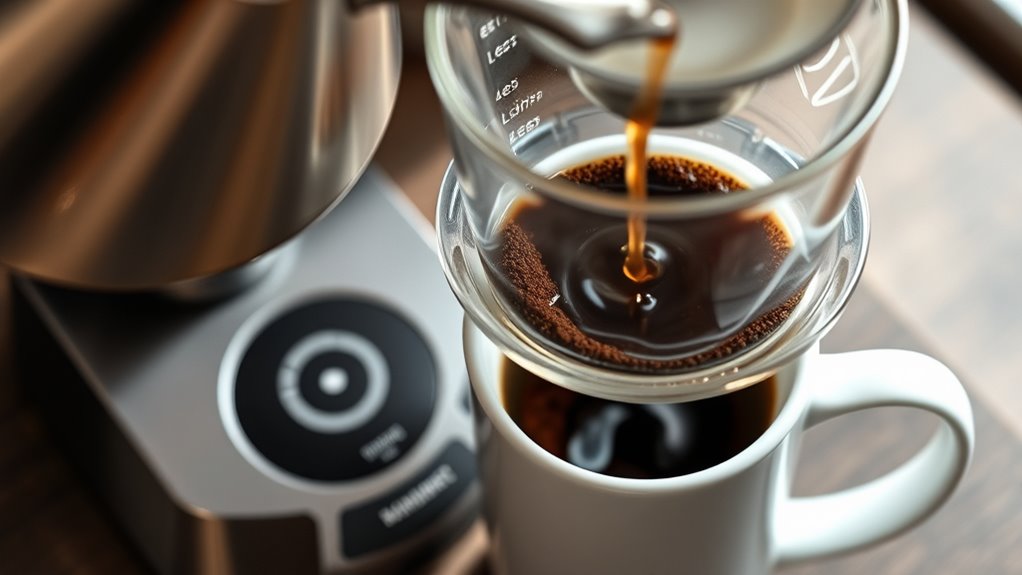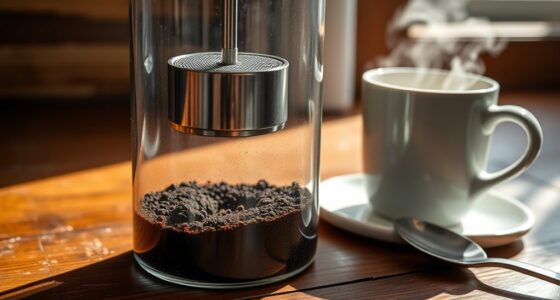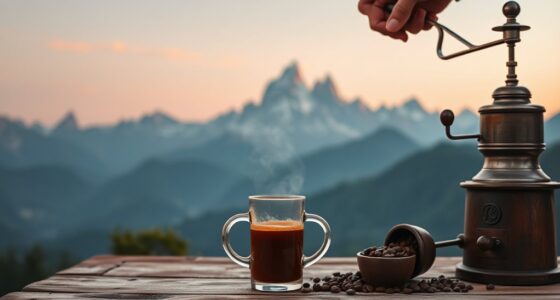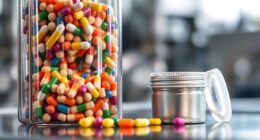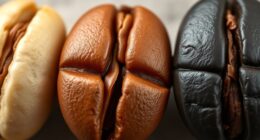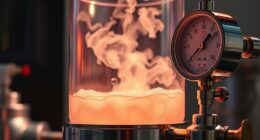A pour-over brew ratio is simply the amount of coffee you use compared to the water added, affecting flavor and strength. For a light, balanced cup, aim for about 1:15 (coffee to water). Adjusting this ratio changes the strength — more coffee makes it bolder, less makes it lighter. Using accurate measurements and fine-tuning your grind and pouring technique can help you perfect your brew. Keep exploring to learn how to get the best results every time.
Key Takeaways
- The pour-over brew ratio is the amount of coffee to water used, typically around 1:15 for balanced flavor.
- Adjusting the ratio changes the strength and clarity of the coffee; more water results in a lighter taste.
- Precise measurement with a scale ensures consistency and helps fine-tune flavor preferences.
- Lighter roasts often need stronger ratios to highlight delicate notes, while darker roasts may use more water to mellow flavors.
- Proper ratios, combined with good pouring technique, lead to a smooth, balanced, and flavorful cup every time.
What Is a Brew Ratio and Why Does It Matter?
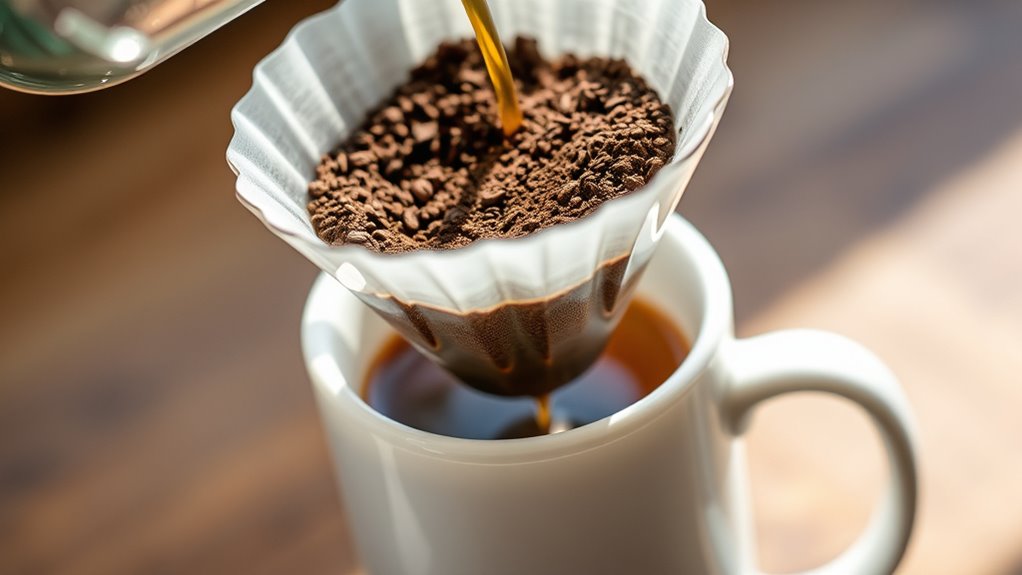
Have you ever wondered why some pour-over coffees taste perfect while others fall flat? It all comes down to the brew ratio, which directly impacts coffee extraction and brewing efficiency. A proper brew ratio balances the amount of coffee to water, ensuring you extract the right flavors without under- or over-extraction. When the ratio is off, your coffee can taste sour, bitter, or bland. A precise brew ratio helps optimize coffee extraction, maximizing flavor and aroma. It also makes your brewing process more consistent, so every cup is just right. Understanding and adjusting your brew ratio allows you to control how much solubles are extracted from the coffee grounds, leading to a richer, more balanced cup. Additionally, maintaining the right brew ratio is essential for achieving a pleasing farmhouse bedroom ambiance that emphasizes comfort and authenticity. In short, it’s the foundation of a great pour-over.
Standard Brew Ratios for Different Coffee Styles
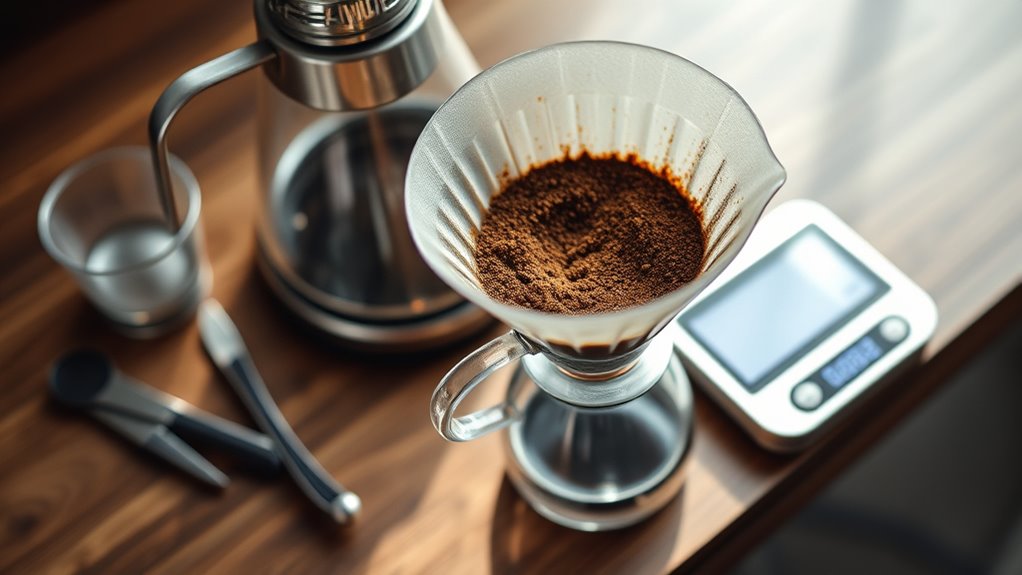
Different coffee styles require specific brew ratios to highlight their unique flavors and characteristics. For a balanced pour-over, a common ratio is 1:15, meaning 1 gram of coffee to 15 grams of water, which suits light and medium roasts. For espresso-style coffees, a more concentrated ratio like 1:2 or 1:2.5 works best. When selecting coffee beans, opt for fresh, high-quality beans suited to your desired style. Proper equipment calibration guarantees you can consistently achieve these ratios, whether it’s your scale or dripper. Adjusting ratios for darker roasts might involve slightly more water to mellow the flavors, while lighter roasts sometimes benefit from a stronger ratio to extract delicate notes. Matching your brew ratio to your coffee style enhances flavor and clarity. Consistent measurement techniques are essential for maintaining accurate ratios and achieving the perfect brew every time.
How to Measure and Adjust Your Brew Ratio
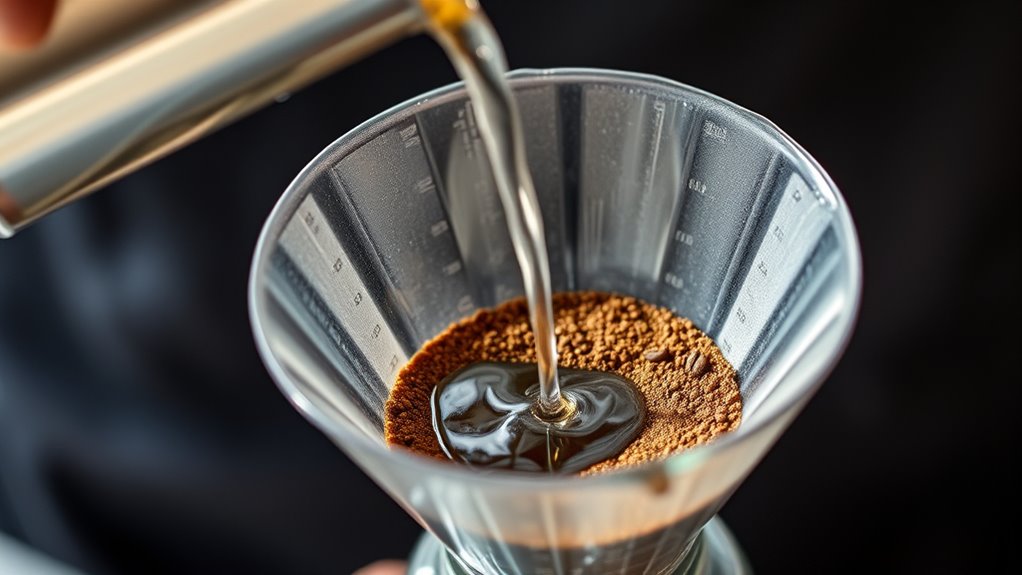
To achieve the perfect brew ratio, you need to measure both your coffee and water accurately from the start. Use a scale to weigh your coffee grounds and water, ensuring consistency. Adjustments may be necessary based on your taste preferences, grind size, and brewing time. For example, a finer grind increases extraction, which can affect the flavor and strength, so you might need to tweak the amount of coffee or water. Keep an eye on brewing time—if it’s too long or short, your ratio may need balancing. Visualize this process with:
- A spoonful of coffee grounds, perfectly leveled
- A scale showing precise weight measurements
- A timer tracking your brewing duration
Additionally, understanding the importance of contrast ratio can help you select a suitable projector for your home cinema, ensuring vibrant image quality that enhances your viewing experience. These steps help you fine-tune your brew ratio for ideal flavor.
The Impact of Brew Ratios on Flavor and Strength
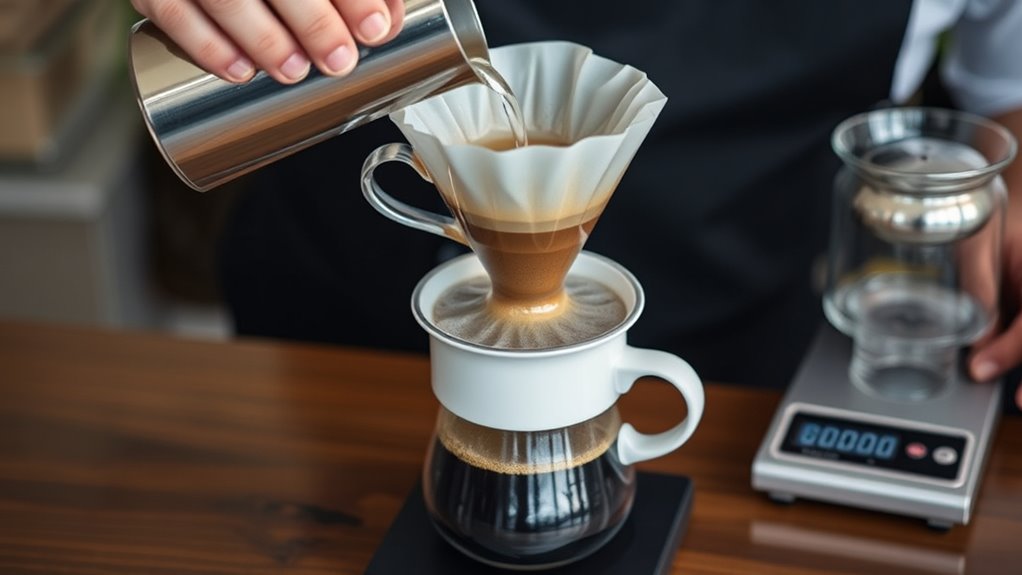
Your brew ratio directly influences how strong and flavorful your coffee tastes. Adjusting the ratio allows you to balance the richness and brightness to suit your preferences. Using consistent techniques guarantees your results stay reliable every time. Additionally, understanding the safety measures involved in AI development can help ensure responsible innovation in related fields.
Strength Control Through Ratios
Adjusting the brew ratio directly influences the strength of your pour-over coffee, allowing you to tailor the flavor to your preference. A higher coffee-to-water ratio produces a stronger, bolder cup, while a lower ratio yields a lighter taste. To control strength effectively, consider your coffee grind size and water temperature, as they affect extraction. A finer grind increases extraction, making your coffee stronger, whereas a slightly cooler water temperature can slow extraction, resulting in a milder brew. Visualize these effects:
- Rich, dark liquid pooling in your dripper
- The aroma intensifying with a denser coffee bed
- A balanced, full-bodied sip that satisfies your preference
Flavor Balance Adjustment
Brew ratios not only influence the strength of your coffee but also shape its overall flavor profile. Adjusting the ratio can enhance or mellow coffee acidity, making bright or smooth flavors more prominent. A higher coffee-to-water ratio often amplifies acidity and brightness, while a lower ratio tends to mellow these qualities. Brewing temperature also plays a role; higher temperatures extract more vibrant, tangy notes, but can also increase bitterness if overdone. By tweaking your brew ratio, you control how these elements come together, balancing flavor and strength. Experimenting with different ratios helps you find the ideal harmony between acidity, aroma, and body, ensuring your coffee tastes just the way you like it. Proper brew ratio adjustment is essential for achieving optimal extraction and flavor clarity in your coffee.
Brew Consistency Tips
Maintaining consistent brew ratios is essential for achieving reliable flavor and strength in your coffee. To do this, pay attention to key factors like bean freshness and grind size, which influence extraction and overall taste. Use a scale to measure your coffee and water precisely, ensuring each brew matches your desired ratio. Consistency also depends on controlling variables such as water temperature and pouring technique. To keep your results steady, consider these tips:
- Keep your beans fresh by storing them properly and buying in small batches
- Adjust grind size to match your brew ratio, avoiding over- or under-extraction
- Develop a pouring routine to ensure even saturation and extraction every time
- Monitoring your brew ratios regularly helps you fine-tune your process for optimal flavor.
Following these steps helps you produce a balanced, flavorful cup with consistent strength.
Tips for Achieving the Perfect Ratio Every Time

Achieving the perfect pour-over brew ratio consistently requires attention to detail and a bit of experimentation. To optimize coffee extraction, start by measuring your coffee and water precisely. Use a digital scale to ensure accuracy, aiming for the ideal ratio based on your preferred strength. Adjust your grind size; a medium grind usually works best, but finer or coarser adjustments can impact extraction and flavor. A consistent grind size allows water to flow evenly through the coffee, preventing under- or over-extraction. Keep track of your ratios, brewing time, and grind settings to refine your process. Small tweaks can make a significant difference, helping you achieve a balanced, flavorful cup every time. Practice and patience are key to mastering the perfect pour-over ratio. Regularly monitoring your brew ratio can also help identify the adjustments needed for the perfect cup.
Common Mistakes to Avoid With Brew Ratios
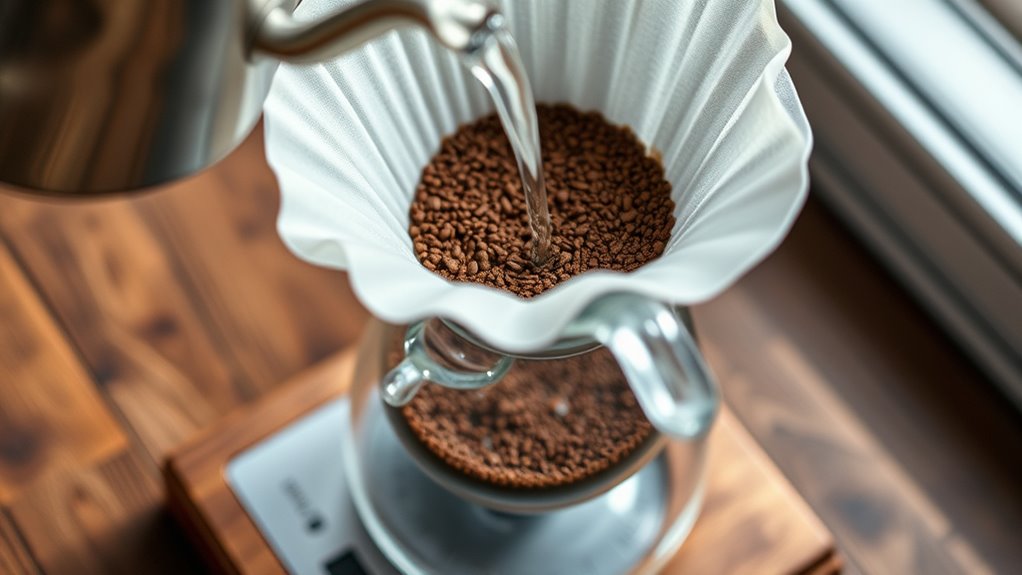
One common mistake is using an inconsistent or imprecise ratio, which can lead to unpredictable flavors and weak or overly strong coffee. This often results in over extraction pitfalls, where the brew becomes bitter, or uneven extraction, causing inconsistent taste. To avoid these pitfalls:
Using precise ratios ensures balanced, flavorful pour-over coffee every time.
- Use a scale to measure your coffee and water precisely, ensuring consistency.
- Adjust grind size carefully; too fine can cause over extraction, too coarse can lead to under-extraction.
- Monitor pour technique to distribute water evenly, preventing uneven extraction and flavor imbalance.
- Additionally, understanding tuning concepts can help refine your brewing process for better flavor control.
Ignoring these steps increases the risk of brewing a subpar cup with harsh or flat notes. Staying vigilant about your ratios and process helps produce a balanced, flavorful pour-over every time.
Frequently Asked Questions
Can Brew Ratios Be Customized for Personal Taste Preferences?
Yes, you can customize brew ratios to match your personal taste preferences. Ratio flexibility allows you to experiment with different coffee-to-water proportions, creating a stronger or milder brew. By adjusting the ratio, you control the strength and flavor profile of your pour-over coffee. Feel free to tweak it until you find the perfect balance that suits your taste buds, making each cup uniquely yours.
How Do Different Grind Sizes Affect the Ideal Brew Ratio?
Different grind sizes markedly impact your brew ratio. A finer grind increases extraction, making your coffee stronger, so you might use a slightly higher coffee-to-water ratio for balanced brew strength. Conversely, a coarser grind results in a weaker brew, so lowering the ratio helps prevent over-extraction and bitterness. Adjusting the grind size allows you to fine-tune your brew ratio, ensuring your pour-over coffee matches your preferred strength and flavor profile.
Are There Specific Ratios for Brewing With Alternative Coffee Methods?
Yes, different coffee methods often require specific ratios to optimize coffee extraction and flavor balance. For example, French press typically uses a 1:15 ratio, while Aeropress might need around 1:12. Adjusting ratios helps control extraction, ensuring your coffee isn’t too weak or too strong. Experiment with these ratios to find the perfect balance for each method, enhancing flavor and overall brewing experience.
How Does Water Temperature Influence the Effectiveness of a Chosen Brew Ratio?
While water temperature might seem secondary, it actually deeply impacts your brew ratio’s effectiveness. Higher temperatures enhance water chemistry, promoting better extraction balance, which can make your coffee taste richer and more complex. Conversely, lower temps risk under-extraction, weakening flavors even if your ratio is perfect. So, adjusting water temperature isn’t just about taste—it’s about optimizing how your chosen ratio interacts with your coffee, ensuring a balanced, flavorful cup every time.
Can Brew Ratios Be Adjusted for Brewing Larger or Smaller Batches?
Yes, you can adjust brew ratios for larger or smaller batches by scaling recipes accordingly. When scaling recipes, you simply multiply or divide the amount of coffee and water to match your desired batch size. Keep in mind that small adjustments may slightly alter extraction, so you might need to tweak the brew ratio or brewing time to maintain ideal flavor. Always measure carefully to guarantee consistency in your results.
Conclusion
Think of your pour-over brew ratio as the recipe to your perfect cup—getting it just right transforms simple ingredients into a flavorful masterpiece. When you understand and tweak these ratios, you’re the artist shaping every sip’s strength and taste. So, don’t be afraid to experiment and find what works best for you. With a little practice, your coffee will become a symphony of flavors, hitting all the right notes every time.
